Introducing Magnify Search: The Century Electronics Demo
|
Topics: |
Magnify allows you to ask a question across the whole enterprise. By clicking the Search button, Magnify accesses relevant data, such as reports and unstructured content, across various platforms and applications.
- To navigate to the Century Electronics Demo, use the following
URL:
http://host:port/wfcontext_root/search
where:
- host:port
-
Is the machine name and port number where WebFOCUS is installed.
- wfcontext_root
-
Is the WebFOCUS application root.
Note: Sample or default URLs are for informational purposes only and may not resolve correctly, if at all.
The default link to the Century Electronics Demo is:
http://localhost:8080/ibi_apps/search
The search page displays, as shown in the following image.
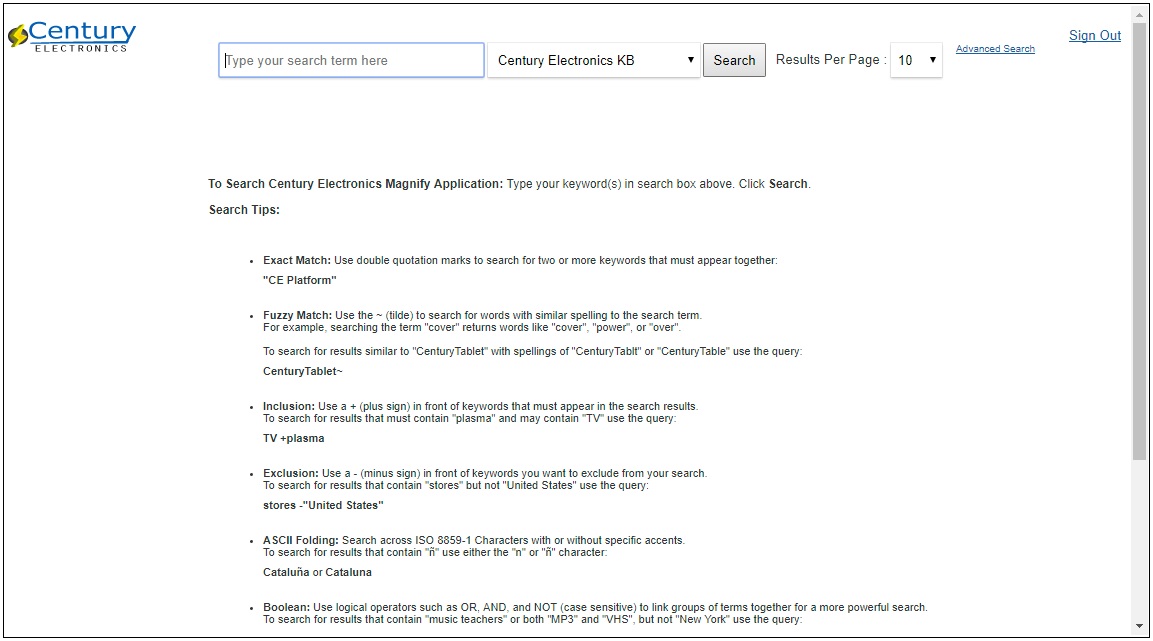
- Type Camera in the input field.
- Expand and review the Collection List drop-down menu, as shown
in the following image.
The Collection List points to one or more Magnify index libraries, where enterprise information has been organized and made searchable, as shown in the following image.
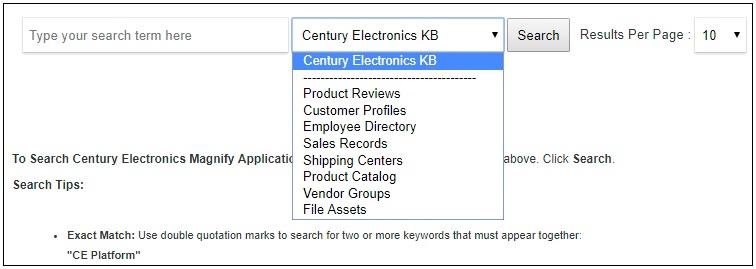
- Review the Search Tips.
- Change Results Per Page from 10 to 20.
- Submit the search by clicking the Search button.
The search results display, as shown in the following image.
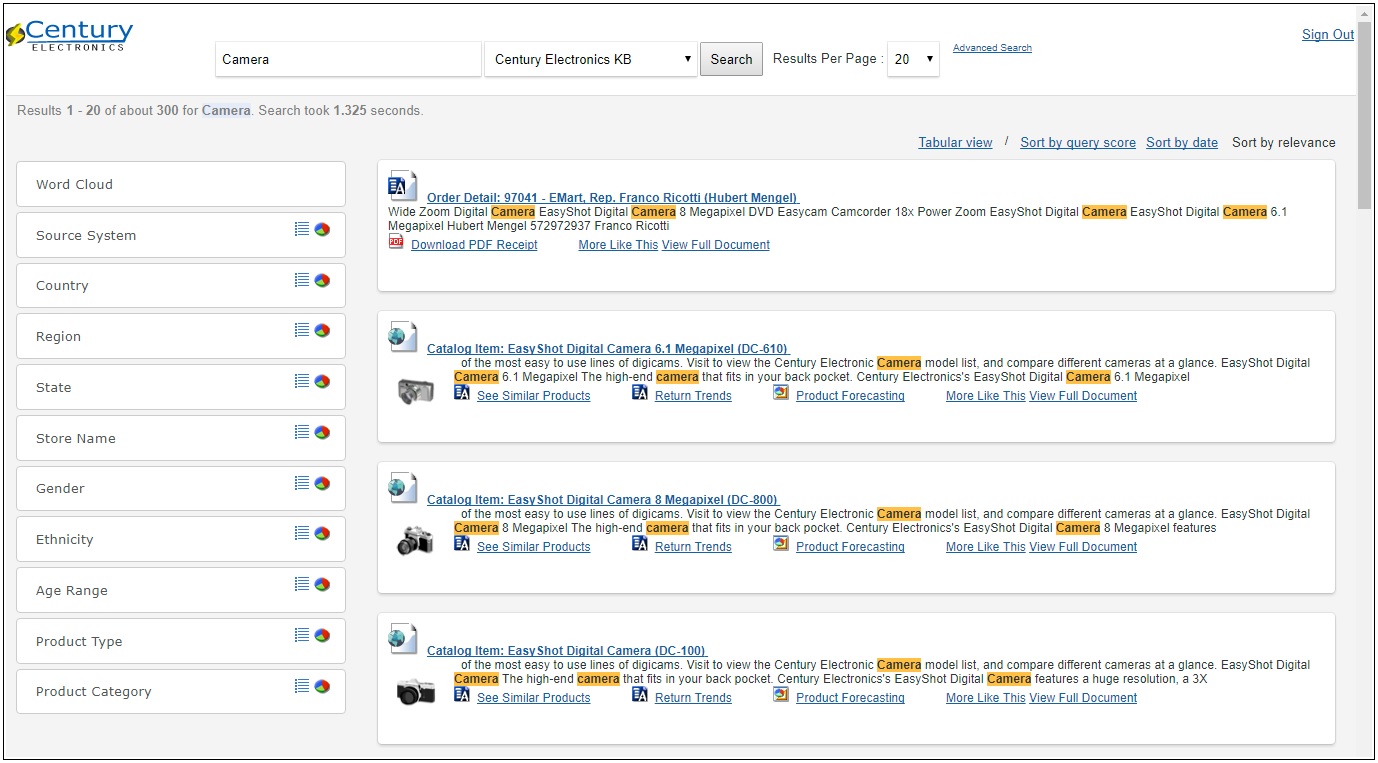
The results have the following elements:
- General information, including the number of records and speed.
- Results, including the main link, snippet, and additional links.
- Dynamic Categorization Tree and the Breadcrumb trail.
- Expand Source System to
filter that category, as shown in the following image.
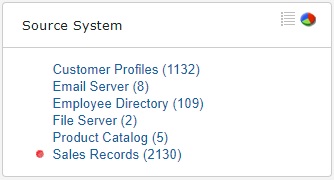
- Click Sales Records to limit the results
to sales records, as shown in the following image.

The Breadcrumb trail shows the path from Camera to Sales Records.
- Expand Source System to
filter that category, as shown in the following image.
- Sorting. You can sort search results by various ranking
attributes. Sort by relevance is selected by default.
- Click Sort by query score, then click Sort by date.
- Facetcounts. The category tree count includes all matching items in the entire index library, and is not limited to the maximum records
returned in the search.
Note: Although only 300 records are returned due to the record limit, there are actually 2,130 records that match the search criteria associated with the Sales Records category under Source System, as shown in the following image.

- Analytics. You can use the tabular view to perform additional
analytics on your search results with its embedded analytic engine.
For example, you can review how many camera orders are found by
country and then look deeper by region.
- To see a tabular view, click Tabular View.
- Click the drop-down arrow on the Title column.
- Select Rollup, and then Country,
as shown in the following image.
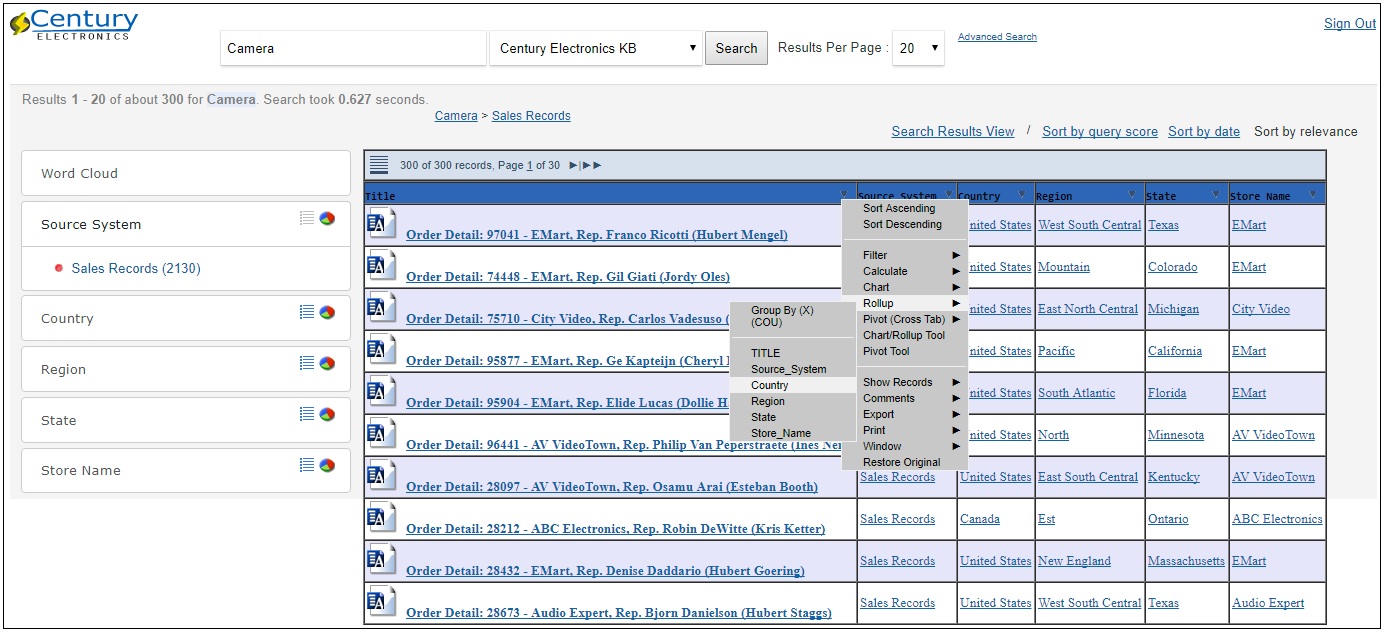
- Click the chart drop-down menu, and select Group
By (X) and then Region, as shown
in the following image.
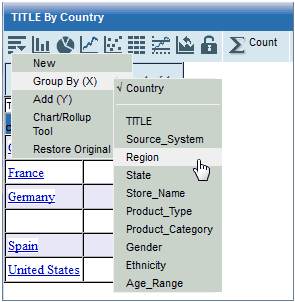
The Region field is added to the Rollup chart, as shown in the following image.
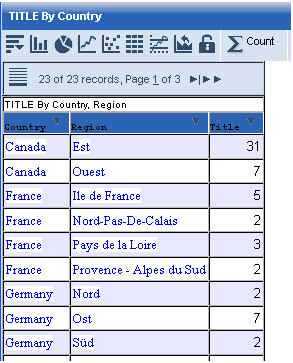
- Click the X in the upper-right corner to close the Rollup chart.
- Drill Down into Business Intelligence Reports.
- Click Search Results View.
- Click on the first main title link, Order Detail:
28006, as shown in the following image.

Notice that multiple purchases have been aggregated into a single searchable order, as shown in the following image.

Signing Out From Magnify Search
After you have completed performing your searches for a given session, you can sign out from Magnify Search if required.
Magnify Search includes a Sign Out hyperlink, located in the upper-right corner of the screen, as shown in the following image.

Click Sign Out to log out from Magnify Search. You are returned to the WebFOCUS Sign In screen.
Magnify Advanced Search Syntax
Magnify features custom query syntax, which allows you to focus searches on specific results:
- Exact Match. Use double quotation marks (“) to search
for two or more keywords that must appear together.
To search for results where the term CE Platform is found together, use the following query:
"CE Platform"
- Fuzzy Match. Use the tilde (~) to search for words with
similar spellings.
To search for results similar to CenturyTablet but with spellings such as CenturyTablt or CenturyTable, use the following query:
CenturyTablet~
An additional, optional parameter can specify the required similarity. The accepted values are between 0 and 1, with values closer to 1 signifying higher similarity. For example:
CenturyTablet~0.7
- Proximity Match. Use the tilde (~) followed by a number
to represent the maximum number of words apart that two terms can
be found.
For example, searching for "red apple"~3 returns only results where red and apple are found within three words of each other.
To search for results where the term Tablet is found within five words of the term money, use the following query:
"Tablet money"~5
- Inclusion. Use
a plus sign (+) in front of keywords that must appear in the search
results.
To search for results that must contain plasma and may contain TV, use the following query:
TV +plasma
- Exclusion Use a minus sign (-) in front of keywords that
you want to exclude from your search.
To search for results that contain stores but not United States, use the following query:
stores -"United States"
- ASCII Folding. Search across ISO 8859-1 characters with
or without specific accents.
To search for results that contain ñ, use either the n or ñqq character, as shown in the following query:
Cataluña or Cataluna
- Boolean. Use logical operators, such as OR, AND, and
NOT (case-sensitive), to link groups of terms together for a more
powerful search.
To search for results that contain music teachers or both MP3 and VHS, but not New York, use the query:
("music teachers" OR (MP3 AND VHS)) NOT "New York"
Note: You can use parentheses () to group specific clauses.
- Wildcard: Use an asterisk (*) or question mark (?) anywhere
in a term to expand your search.
To perform a single-character wildcard search, use a question mark. This single-character wildcard search looks for terms that match with the single character replaced. To perform a multiple-character wildcard search, use an asterisk. The multiple-character wildcard search looks for zero or more characters. For example:
D?D or D*D
Notes:- You cannot use an asterisk or question mark as the first character of a search string.
- These types of search may take longer than a typical search.
Summary
The Magnify search application gives users access to any and all enterprise information by searching it all at once and including tools to understand that information. Magnify also handles the process of delivering enterprise information for search. Magnify transforms raw data into search content by identifying relationships in the data, categorizing metadata, and making all fields, tables, and data sources searchable. At the same time, Magnify associates each result with Business Intelligence reports tailored by context. For information on how this is done with Format Magnify, see Indexing With Format Magnify.
| WebFOCUS | |
|
Feedback |